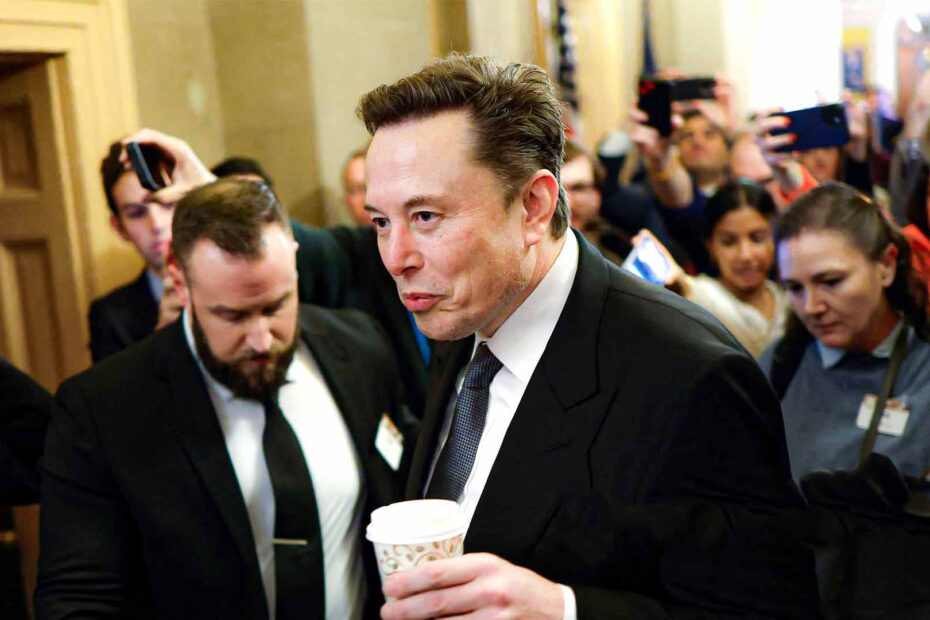Elon Musk has often been at the center of controversies, especially when it comes to his involvement in high-profile crises.
Whether it’s his attempts to solve water contamination issues in Flint, Michigan, his creation of a submarine to rescue children trapped in a cave in Thailand (which ultimately went unused), or his development of ventilators during the early stages of the COVID-19 pandemic, Musk has built a reputation for swooping in with bold ideas.
However, his actions and rhetoric often spark debates about their effectiveness and the underlying motivations. This was again evident recently when Musk found himself involved in the aftermath of the devastating wildfires in Los Angeles, taking a public stance and pushing forward his personal solutions.
On Sunday, Musk made a surprise appearance in the Pacific Palisades neighborhood of Los Angeles, a region heavily affected by the ongoing wildfires. His involvement in this crisis followed a week of inflammatory statements on his social media platform, X, where he criticized the emergency response and blamed a range of factors, from diversity policies to political figures, particularly California Governor Gavin Newsom and his administration, for the mishandling of the fires.
As the world’s richest person and the CEO of Tesla and SpaceX, Musk’s statements and actions are often magnified and scrutinized. His decision to deploy Tesla’s electric Cybertrucks equipped with SpaceX’s Starlink internet terminals in a bid to maintain connectivity in the affected areas caught widespread attention.
Musk’s plan involved strategically positioning these Cybertrucks in a grid pattern across the LA/Malibu area to provide free Wi-Fi and to help residents stay connected amid the fires.
While the idea of using high-tech vehicles to provide vital internet services in such a disaster-stricken area might seem innovative, it raised questions about the practicality and necessity of Musk’s intervention.
The decision to broadcast the emergency briefing on his X platform, where he boasts over 211 million followers, added a layer of media spectacle to the entire effort, suggesting that Musk was not just addressing the crisis but also presenting his involvement as a major news event.
His online posts throughout the weekend highlighted his continued criticism of the handling of the fires, particularly the emergency response. Musk’s statement about using Cybertrucks equipped with Starlink technology was part of his broader response to the crisis, but it was also punctuated with his controversial remarks on social media.
His attacks on Democratic policies and California’s approach to disaster management have ignited debates about the role of technology moguls in public crises and the potential dangers of their unchecked influence.
While Musk’s actions were seen by some as a show of support, others saw them as an opportunity for self-promotion. The presence of the Cybertrucks in the region, even though the vehicles were pulled from Tesla’s deliveries to customers in order to meet the immediate needs of the emergency, further emphasized Musk’s tendency to intertwine his business interests with his philanthropic gestures.
He acknowledged in a post that Tesla had pulled trucks originally slated for customers in order to deploy them to the fire-affected areas, with the promise that new vehicles would be sent to these customers by the end of the week.
This maneuver raised concerns about whether Musk was prioritizing optics over practical aid or whether the vehicles, given their electric nature, could truly contribute meaningfully in a region battling such a large-scale disaster.
Despite Musk’s often critical tone and his history of making provocative claims, his appearance in Pacific Palisades on Sunday took a more subdued turn. He handed out supplies, met with firefighters, and interacted with emergency workers on the ground.
The shift in his tone was noticeable compared to his usual combative and inflammatory social media presence. In one post, Musk shared a clip where he asked a fire official about the availability of water for firefighting efforts. The firefighter explained that the system had been overwhelmed because the firefighters had been using so much water in their efforts to combat the flames.
However, this interaction sparked further controversy. Governor Newsom, who has had a strained relationship with Musk in recent years, was quick to respond to the incident on X. He posted a clip from Musk’s livestream, highlighting the moment when Musk questioned the availability of water.
Newsom’s post accused Musk of spreading misinformation, with the caption reading, “@ElonMusk exposed by firefighters for his own lies.” The tension between Musk and Newsom, once friends, has become emblematic of the polarized political environment in California, where Musk’s outspoken stance on various issues, from the pandemic to politics, has increasingly put him at odds with state leaders.
This exchange brought to light the growing divide between tech moguls like Musk and elected officials. While Musk may have had good intentions in offering aid during the crisis, his involvement was seen by some as more about self-promotion and stirring controversy than providing meaningful help.
Newsom’s swift response to call out Musk for his alleged misinformation also highlighted the challenges of navigating public discourse during a crisis. As a figure with immense influence, Musk’s ability to sway public opinion with a few tweets or livestreams carries significant weight, for better or for worse.
As the fires continued to ravage the region, Musk’s actions and statements became just another chapter in his complicated legacy of crisis interventions. While he may have provided some technical solutions, like the deployment of Cybertrucks and Starlink terminals, the real impact of his involvement remains unclear.
Critics will likely continue to question whether his actions are driven by genuine altruism or the desire to expand his brand, while others may view him as a bold innovator trying to make a difference in an increasingly chaotic world. Ultimately, Musk’s role in this crisis, like many of his previous endeavors, is likely to spark debate long after the fires are out and the immediate needs have been met.
